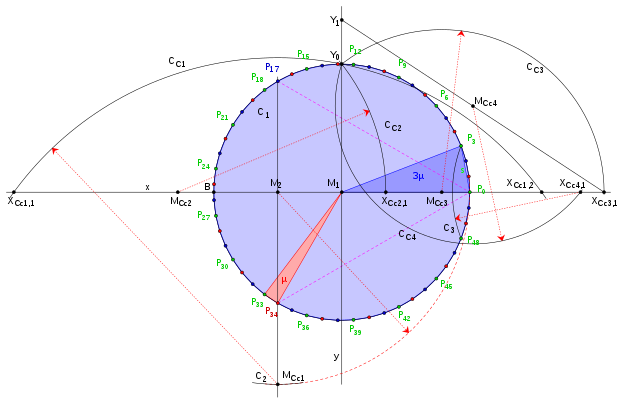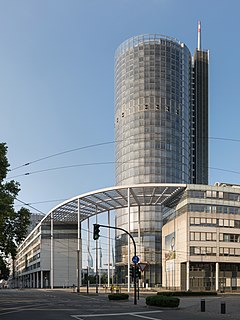51-corner
The 51-Eck or Pentakontahenagon is a geometric figure , and a polygon ( polygon ). It is determined by fifty-one points and their fifty-one connections called lines , sides or edges.
Regular 51-sided
According to Carl Friedrich Gauß and Pierre-Laurent Wantzel, the regular 51-gon is a constructible polygon , since the number of its sides can be represented as the product of a power of two with pairwise different Fermat's prime numbers ( ).
Sizes
| Sizes of a regular 51-sided | ||
|---|---|---|
| Interior angle |
|
|
|
Central angle
(Center angle) |
||
| Side length | ||
| Perimeter radius | ||
| Inscribed radius | ||
| height | ||
| Area | ||
Mathematical relationships
Interior angle
The interior angle is enclosed by two adjacent side edges. In the general formula for regular polygons, the variable stands for the number of corner points of the polygon. In this case, the number should be used for the variable .
Central angle
The central angle or center angle is enclosed by two adjacent circumferential radii . Enter the number for the variable in the general formula .
Side length and perimeter radius
The 51-gon can be divided into fifty-one isosceles triangles, so-called sub - triangles . From half of such a partial triangle, i.e. from a right-angled triangle with the cathetus (half the side length) , the hypotenuse (circumferential radius) and the half central angle , the side length is obtained with the help of trigonometry in the right triangle as follows
the circumferential radius is obtained by forming
Inscribed radius
The incircle radius is the height of a partial triangle, perpendicular to the side length of the 51 corner. If the same right-angled triangle is used again for the calculation as for the side length, the inscribed radius applies
height
The height of a regular 51-sided results from the sum of the incircle radius and the circumferential radius .
Area
The area of a triangle is generally calculated . For the calculation of the 51-gon the results of the side length and the incircle radius are used, which is used for the height .
- from this follows for the area of a partial triangle
- summarized it results
and for the area of the entire 51 gon
construction
As described above in the regular 51-square , the 51-square can be displayed as a construction with compass and ruler . Since the number of its vertices results from the multiplication of the two Fermat prime numbers and , the regular 51-vertex can be found by expanding an already known construction of the seventeen- sided. The two polygons triangle and seventeenth-corner (the number of sides corresponds to the Fermat prime numbers or ) are placed on top of each other symmetrically with regard to their central angles in the common circumference, as is shown e.g. B. Johannes Kepler shows in his work WELT-HARMONIK in the construction of the fifteen -sided .
In principle, one of the three methods described in Siebzehneck can be selected as the basis for the construction . For reasons of the very little effort required, the method of Duane W. DeTemple , from 1991, is used.
Preliminary considerations
In the drawing, the Siebzehnecks by Duane W. Detemple (Figure 1) which is well recognizable, Mittelsenkrechte from cuts not only the arc but also the perimeter. If this intersection point is marked as, it lies directly next to the corner point. This results in the central angle with the angular width of an equilateral triangle , which is added geometrically clockwise to the central angle of the seventeenth- corner .
Hence for
- Central angle of the circular sector
- Central angle of the circular sector
- because of
- Central angle of the 51 gon
- also applies
Thus, the line is a side length and a corner point of the 51-gon sought.
The position of the corner point of the 51-gon also results from the number of side lengths contained in the central angle
- it follows
- starting from the corner point not counted , the clockwise 17th corner point corresponds to the corner point that is counted counterclockwise.
The 17th corner point of the 51 corner is therefore exactly opposite the 34th corner point in relation to the central axis .
Construction description
The identifiers in Figure 2 that have been changed compared to the original correspond to those used today.
- Draw a straight line (analytically an X-axis) and determine a point on it, the later center point of the polygon (analytically a coordinate origin).
- Drawing a circle as a radius (analytically a unit circle) around . There are two intersection points , the corner point of the polygon and the counterpoint .
- Establishing the vertical (analytically a Y-axis) on the straight line in . The point of intersection results .
- Halving the distance in .
- Establishing the perpendicular on the straight line in . The two intersections with are the corner points and of the 51 corner.
- Draw the arc around with the radius . The intersection with the vertical is .
- Now the first Carlyle circle is drawn through the point ; the intersections are and .
- The route is halved. One receives .
- Draw a second Carlyle-circle around through . The points of intersection with x are the points and (the latter is not shown as it is no longer required).
- The route is halved. One receives .
- Drawing a third Carlyle circle around through . The points of intersection with x are the points and (the latter is also not shown as it is no longer required).
- Removal of the route on from from from. You get point
- Connect the points and with a segment.
- Halve the route . You get point .
- Drawing a fourth Carlyle circle around through . The points of intersection with x are the points and (the latter is not labeled as it is no longer needed).
- Draw an arc around with the perimeter radius . The intersection points with the circumference are the two adjacent points of the 17-sided and thus the points and the 51-sided.
- By repeating the distance on the perimeter , starting with , you get the missing points of a regular 17-gon. Up to this point the construction corresponds to that of the 17-sided.
- By repeatedly subtracting the distance from the perimeter , starting from the points (blue) and (red), you get all the missing corner points of the 51 corner, which can be connected to each other to form the 51 corner.
Occurrence
architecture
The cross-section of the RWE tower in Essen is a regular 51-corner.
literature
- H. Maser: Die Teilung des Kreises ..., Article 365. , in Carl Friedrich Gauss' studies on higher arithmetic , published by Julius Springer, Berlin 1889; Göttingen Digitization Center, University of Göttingen; accessed on March 15, 2018.
Individual evidence
- ↑ Johannes Kepler: WORLD HARMONICS. XLIV. Sentence., Page of the Fifteenth, Page 44. In: Google Books. R. OLDENBURG VERLAG 2006, translated and introduced by MAX CASPAR 1939, p. 401 , accessed on February 21, 2018 .
- ↑ Duane W. Detemple: Carlyle Circles and the Lemoine Simplicity of Polygon Constructions. ( Memento of August 11, 2011 in the Internet Archive ). The American Mathematical Monthly, Vol. 98, No. 2 (Feb., 1991), pp. 101-104 ( JSTOR 2323939 ) accessed on February 16, 2018.
































































































